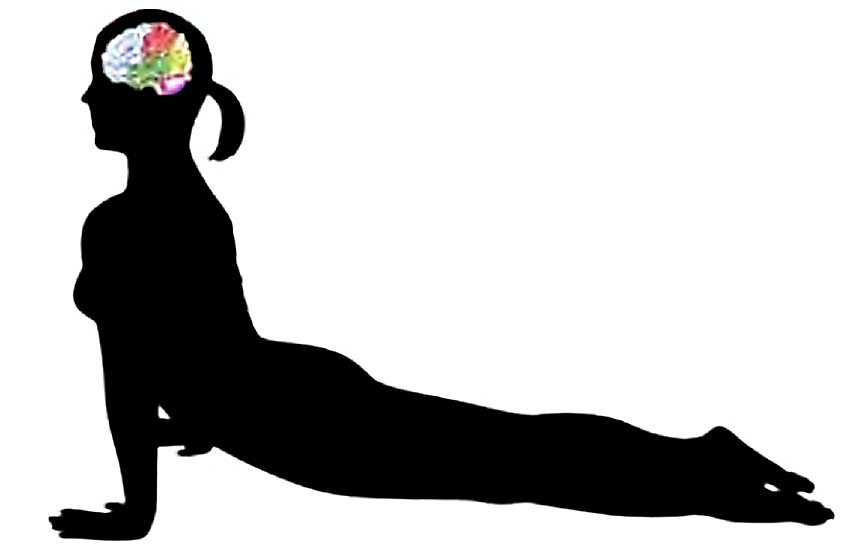My Dad has been going to yoga for over 6 years. I had always been interested in exercise and athletics, but I didn’t get what was so great about this odd form of extended stretching. I also had a separate interest in neuroscience, but little did I know that this ancient practice would re-shape my understanding of the relationship between the body and the brain.Three times a week at 7AM my Dad drives to a dance studio five blocks from the beach. In the bright, hardwood room, which sits above a Radioshack, a muscular man with a shaved head and board shorts whispers instructions in a mix of English and Sanskrit. My Dad, and the rest of the class – mostly lithe, tanned actresses and trophy wives wearing black Lululemmon tights – bend and twist into strange shapes. The windows fog over with the moisture of their collective breath.
Yoga can supposedly improve depressive symptoms and immune function, as well as decrease chronic pain, reduce stress, and lower blood pressure. These claims have all been made by yogis over the years, and it sounds like a lot of new age foolishness. Surprisingly, however, everything in that list is supported by scientific research. It may sound like magic that posing like a proud warrior or a crow could have such extensive effects, but it’s not magic. It’s neurobiology. This next statement may sound to you either profound or extremely obvious, but it comes down to this: the things you do and the thoughts you have change the firing patterns and chemical composition of your brain. Even actions as simple as changing your posture, relaxing the muscles on your face, or slowing your breathing rate, can affect the activity in your brain (beyond, of course, the required activity to make the action). These changes are often transient, but can be long-lasting, particularly if they entail changing a habit.
The first time I woke up early to join my Dad for yoga, I was picturing a roomful of people calmly twisting into pretzels to achieve enlightenment. As class was about to start my Dad mumbled from the next mat over, « You’re supposed to breathe through your nose while constricting the back of your throat to make a sound like the ocean. » That sounded a little hippy-dippy, touchy-feely to me, but I tried it anyway. I realized only later that this was one of the key factors in yoga’s effect on the brain.
Within 15 minutes I was dripping so much sweat I could barely hold a downward-facing dog. Yet through all the poses the instructor kept talking about how we were supposed to keep our breathing calm, and steady. Remain calm? Are you kidding me? My muscles were shaking as I tried to hold myself in pushup position 4 inches above the floor. When the teacher asked us to twist so that the right shoulder dipped under the right knee, I could barely expand my lungs. He asked us to do a back bend, and my spine creaked, and painfully resisted my attempts. Remain calm? For goodness sake, he wanted us to stand on our heads!
As a neuroscientist, despite my initial incredulity, I came to realize that yoga works not because the poses are relaxing, but because they are stressful. It is your attempts to remain calm during this stress that create yoga’s greatest neurobiological benefit.
Your brain tends to react to discomfort and disorientation in an automatic way, by triggering the physiological stress response and activating anxious neural chatter between the prefrontal cortex and the more emotional limbic system. The stress response itself increases the likelihood of anxious thoughts, like « Oh god, I’m going to pull something, » or « I can’t hold this pushup any longer ». And in fact, your anxious thoughts themselves further exacerbate the stress response.
Interestingly, despite all the types of stressful situations a person can be in (standing on your head, running away from a lion, finishing those TPS reports by 5 o’clock) the nervous system has just one stress response. The specific thoughts you have may differ, but the brain regions involved, and the physiological response will be the same. The physiological stress response means an increase in heart rate, breathing rate, muscle tension and elevation of cortisol and other stress hormones. The fascinating thing about the mind-body interaction is that it works both ways. For example, if you’re stressed, your muscles will tense (preparing to run away from a lion), and this will lead to more negative thinking. Relaxing those muscles, particularly the facial muscles, will push the brain in the other direction, away from stress, and toward more relaxed thoughts. Similarly, under stress, your breathing rate increases. Slowing down your breathing pushes the brain away from the stress response, and again toward more relaxed thinking.
So how does this all fit together? As I stated before, the stress response in the nervous system is triggered reflexively by discomfort and disorientation. The twisting of your spine, the lactic acid building up in your straining muscles, the uneasy feeling of being upside down, the inability to breathe, are all different forms of discomfort and disorientation, and tend to lead reflexively to anxious thinking and activation of the stress response in the entire nervous system. However, just because this response is automatic, does not mean it is necessary. It is, in fact, just a habit of the brain. One of the main purposes of yoga is to retrain this habit so that your brain stops automatically invoking the stress response
Some people might think that the stress response is an innate reflex and thus can’t be changed. To clarify, the response is partly innate and partly learned in early childhood. Yes, the stress response comes already downloaded and installed on your early operating system. However, this tendency is enhanced, by years of reinforcement. In particular, you absorb how those around you, particularly your parents, react to stressful situations. Their reactions get wired into your nervous system. However, just because a habit is innate, and then reinforced, does not mean it is immune to change. Almost any habit can be changed, or at least improved, through repeated action of a new habit.
To give an example of changing a similarly innate reaction, I’m going to go out on a limb and assume you have a gag reflex. This gag reflex gets in the way of many college freshmen as they struggle through the college socialization process of chugging a beer. Most have a difficult time. However, by the time senior year spring break rolls around, many of them have learned how to largely suppress that reflex. Like your gag reflex, just because your stress response is innate and automatic doesn’t mean it can’t be reshaped through sustained, and intentioned practice.
For some people waking up at 6:30AM to go to a yoga class would automatically trigger their stress response. The good news is that you don’t actually have to go to a class to practice yoga. The poses most people associate with yoga are just a particular way of practicing yoga called the asana practice (« asana » translates to « pose »). The asanapractice challenges you in a specific way, but life itself offers plenty of challenges on its own. Under any stressful circumstance you can attempt the same calming techniques: breathing deeply and slowly, relaxing your facial muscles, clearing your head of anxious thoughts, focusing on the present. In fact, applying these techniques to real life is what yoga is all about. Yoga is simply the process of paying attention to the present moment and calming the mind. Over time you will start to retrain your automatic stress reaction, and replace it with one more conducive to happiness and overall well-being. After going back to my Dad’s yoga class a few times, I eventually came to the realization that not only can you practice yoga in real life, but, conversely, you could go to a yoga class and not really be doing yoga. Some of those hot, tan, thin women around him might just be placing their legs behind their heads, and still not be focusing on keeping their breath calm and steady, or their minds clear (Note: I have removed a lame blonde joke). They might be focused on something else entirely. Without the sustained intention of focusing on the present, and calming the mind, going to a yoga class is literally just going through the motions. Come to think of it, who knows if my Dad is really doing yoga, and not just staring at the women with their legs behind their heads? Well, all I can say is that from my mat I can hear his breaths rolling deep and slow like the ocean, and he has no problem standing on his head. http://www.psychologytoday.com/blog/prefrontal-nudity/201109/yoga-changing-the-brains-stressful-habits


I’m glad this post made your day 🙂
I will be posting more soon…
If you LIKE my professionnal page on FB, you will have access to some of my posts in english.
http://www.facebook.com/GuerinaPellizzi/
I send a post every Monday morning, but not always in English 🙁
thank you for your comment and have a nice day!
This is one awesome blog post.Really thank you! Want more.